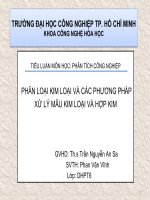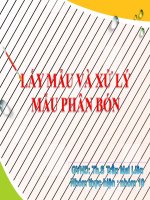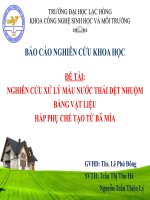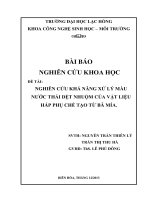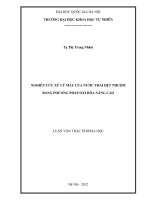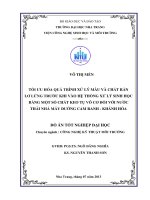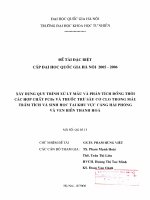Tóm tắt luận án: Phân tích Auramin O, Sundan I, Sudan II trong thực phẩm bằng phương pháp RPHPLC sử dụng vật liệu nanosilica để xử lý mẫu.
Bạn đang xem bản rút gọn của tài liệu. Xem và tải ngay bản đầy đủ của tài liệu tại đây (296.27 KB, 29 trang )
MINISTRY OF EDUCATION OF TRAINING
HANOI NATIONAL UNIVERSITY OF EDUCATION
PHAM THI CHUYEN
ANALYSIS OF AURAMINE O, SUDAN I, SUDAN II
IN FOOD BY RP-HPLC METHOD USING NANOSILICA
MATERIAL FOR SAMPLE TREATMENT
Major: Analytical Chemistry
Code: 9.44.01.18
PhD THESIS ABSTRACT
Hanoi - 2022
Place:
Department of Analytical Chemistry – Faculty of Chemistry
Hanoi National University of Education
Advisors:
1. Assoc. Prof. PhD. Dang Xuan Thu
Hanoi National University of Education
2. PhD. Nguyen Bich Ngan
Hanoi National University of Education
Reviewer 1: Assoc. Prof. PhD. Pham Thi Ngoc Mai
University of Science, Vietnam National University Hanoi
Reviewer 2: Assoc. Prof. PhD. Huynh Van Trung
Institute for Technology of Radioactive and Rare Elements
Reviewer 3: Assoc. Prof. PhD. Duong Thi Tu Anh
Thai Nguyen University of Education
The thesis is completed in Hanoi National University
of Education in 2022
The thesis can be found at:
- National Library of Vietnam
- Library of Hanoi National University of
Education
1
INTRODUCTION
1. Urgency and reason of the thesis
According to Circular No.24/2019/TT-BYT issued on August
30, 2019, in Vietnam, there are 57 colorants allowed to be used in
food, including natural extracted colorants and synthetic colorants.
Thus, compared with Decision 3742/2001/QD-BYT issued in 2001
(which allowed the use of 21 colors), the number of color products in
the list increased significantly, so the demand for chemical products
has increased significantly. Food colorings are becoming more and
more popular. However, there are production facilities that ignore
food safety conditions to use toxic synthetic colors that are not
allowed to be used on food to color food. These dyes have the
advantage of being inexpensive, standard and fast, and colorfast, but
most of them contain toxic substances that can cause disease, which
are classified as potentially carcinogenic substances according to
International Agency for Research on Cancer (IARC) such as Sudan,
Auramine O, Rhodamine B, and Ponceau 3R. In fact, controlling the
use of synthetic food colorings is difficult in Vietnam because they
are used privately and on a small scale. Many food products on the
market have been found to contain dyes that are not allowed for
food.
In Vietnam, Auramine O and Sudan dyes are not present in the
National technical regulation on Food Additives - Colours QCVN 410:2010/BYT, which means banned substances for food coloring. In
addition, Circular No.21/2019/TT-BNNPTNT of the Ministry of
Agriculture and Rural Development on “Guiding a number of
articles of the Law on Animal Husbandry regarding animal feed”
clearly stipulates in Appendix V: Prohibition of using Use of
2
Auramine O and Auramine O derivatives in animal feed. Currently,
in Vietnam, there is only one certified method for determining
Auramine O in food and animal feed, which is the Vietnam
Standards TCVN 12267:2018 on “Foodstuffs - Determination
of auramine - Liquid chromatography with tandem mass
spectrometric (LC-MS/MS) method”. However, for diverse food
samples with different matrix, applying the same procedure for
extraction and analysis can lead to low recovery efficiency and low
accuracy. In order to find solutions for extraction and separation
suitable for different food samples, and develop a method to quantify
toxic artificial dyes with a simple system of equipment suitable for
laboratory conditions, we conducted the project “Analysis of
Auramine O, Sudan I, Sudan II in food by RP-HPLC method using
nanosilica material for sample treatment”.
2. Goals and main research contents of the thesis
Goal of the study:
Developing a process to analyze Auramine O in food
samples: bamboo shoots, arrowroot vermicelli noodles, pickled
mustard greens, pollen, dried fish and noodles.
Developing a process to analyze the mix of Sudan I and
Sudan II in food samples: dried meat and snack samples.
Contents of the study:
Auramine O:
o Study to find optimal conditions for determination of
Auramine O by HPLC method.
o Study on adsorption conditions of Auramine O in solution
onto Nanosilica made from rice husk (RHNS).
o Investigation of optimal conditions for extraction of
Auramine O from laboratory food samples.
o Application of the studied procedure for the determination
3
of Auramine O in real samples.
Sudan I and Sudan II:
o Study to find optimal conditions for determination of the
mix of Sudan I and Sudan II by HPLC method.
o Study on adsorption conditions of the mix of Sudan I and Sudan II
onto RHNS.
o Investigation of optimal conditions for extraction of Sudan
I and Sudan II from laboratory food samples.
o Application of the studied procedure for the determination
of Sudan I and Sudan II in real samples.
3. Objects, research scope and research methods
Research object and scope
- Sudan I, Sudan II dyes in food samples: dried meat, snack
samples.
- Auramine O in bamboo shoots, vermicelli, pollen, pickles,
dried fish and noodles.
Research Methods
- Method of liquid-liquid extraction of food samples with
organic solvents.
- Dyes adsorption method on nanosilica.
- Analytical method HPLC quantitative dyes, using detector
Diode Array (PDA).
- Molecular absorption spectroscopy method UV-Vis to
determine the maximum absorption wavelengths of dyes solutions.
The thesis uses modern physicochemical methods to
evaluate and identify the characteristics of the adsorbent: FTIR,
SEM, EDX, BET spectroscopy, etc.
Use statistical methods to process results, evaluate
4
experimental data.
4. Scientific significance, practicality and new contributions
- The thesis has proposed a general procedure for the analysis of
dyes (Auramine O and mixture of Sudan I, Sudan II) in food samples.
The process comprises two main stages: sample processing and sample
quantitative analysis by HPLC method. Sample processing is performed
in two ways, with different sample types. Method 1: Extraction with
organic solvents. Method 2: Extraction with organic solvents - Adsorption
of dyes in the extract by Nanosilia made from rice husks - Desorption by
HPLC mobile phase. This is a procedure for analyzing food dyes that has
not been proposed before in any scientific research.
- Sample processing by extraction method with organic
solvents is evaluated as a fast, simple, easy to implement and lowcost method. An important point of the thesis is to provide a method
for extracting dyes by ethanol solvent (extracting auramine O with a
mixture of ethanol: water (v/v 70:30, extracting a mixture of Sudan I
and Sudan II by absolute ethanol). With the amount of sample,
volume of extract, extraction times, temperature, and time, using an
extraction solvent containing ethanol for high extraction efficiency
for many types of food samples (over 90%) while still ensuring the
following factors: non-toxic to the analyst and the environment, low
cost, simple steps and can extract many types of samples at the same
time.
- Using Nanosilica made from rice husks to adsorb dyes from
food sample extracts is also a new point of the thesis. This is an
important step in sample processing towards the “green chemistry”.
Using nanosilica to adsorb Sudan dyes at an isoelectric point while
Sudan is hydrophobic is research that has not been proposed before
(dyes adsorption studies by RHNS have only focused on hydrophilic
5
dyes such as Methylene Blue, Rhodamine B, ...).
- The thesis has given the quantitative analysis results of AO,
Sudan I and Sudan II in many food samples, valuable data regarding
the selection of safe foods for consumers.
5. Layout thesis
The layout of thesis includes 147 pages, introduction 5 pages;
overview 40 pages; experimental 27 pages; results and discussion 56
pages; conclusion 2 pages. The thesis has 56 figures and 42 tables;
reference 11 pages with 13 Vietnamese and 63 English documents.
There are also 6 Appendixes with 6 pages.
6
CHAPTER 1 - OVERVIEW
Chapter 1 introduces information about the issues under the
research scope of the thesis, including:
1.1. Introductions of dyes
1.2.
Binding
mechanism
of
dyess
with
materials
1.3 Auramine O
1.4. Sudan compounds
1.5. Introduction to high-performance liquid
chromatography, focusing on factors that influence the
method, such as mobile phase composition, symmetry coefficient of
chromatographic peaks, peak problems, limit of linearity, limit of
detection LOD, limit of quantitation LOQ.
1.6. Food sample processing methods are also studied through
the following contents: classification of sample treatment methods,
liquid-liquid extraction techniques, application of sample treatment,
trends in application of green sample preparation techniques.
1.7. Overview of nanosilica materials including the
following contents: physical and chemical characteristics of the
material, the basis of statistical processing of adsorption data,
applications of nanosilica materials made from rice husks in
adsorption and enrichment.
7
CHAPTER 2 – EXPERIMENTAL
2.1. Materials, chemicals, tools and equipment
2.2. Research content
2.2.1 Preparation of samples
2.2.1.1. Analytical Sample Auramine O
Fresh bamboo shoots have just been dug up, removed the hard
and old parts, washed, thinly sliced, soaked in diluted salt water,
taken out, boiled, drained, then soaked with vinegar for 4 days, when
smelling bamboo shoots with a characteristic sour smell, take it out,
cut it into pieces, weigh the initial weight - m 1 (g), add a
predetermined amount of Auramine O - mAO (g). Dry to constant
weight in a vacuum oven, weigh m2 g, then grind and sieve finely.
With arrowroot vermicelli noodles samples, which are
handmade in Son La province, the process is strictly controlled so as
not to use any dyes or bleach in the in the production process. Take a
quantity of arrowroot vermicelli noodles and dry it to constant
weight (weigh initial weight m1 g), soak in warm water until soft,
mix AO of predetermined mass (mAO g), stir and grind until
homogenous, dried to constant weight (m 2 g), crushed, sifted finely,
dry powder in a vacuum oven for about 3 hours, product stored in
sealed jars, stored in a dark refrigerator.
2.2.1.2. Mixed analysis sample Sudan I and Sudan II
To determine the optimal conditions for the extraction of food
samples, two dried meat samples, denoted A and B, were used. Fresh
pork was purchased from a VinMart supermarket in Hanoi city. Only
lean meats were used for the experiments. Lean meat is minced to a
maximum size of 5 mm.
8
First, two equal amounts of ground minced lean meat were
placed in two heat-resistant glass cups and 0,1 g NaCl was added.
Cup A contained only the meat sample, whereas cup B contained the
meat sample and Sudan I and II. A few drops of alcohol were added to
allow the infiltration of the dye into the meat and ensure even coloring.
Then, the meat samples were stored for one day in a refrigerator to
allow the dyes to penetrate the substrate evenly. Dried meat samples
were ground and passed through a 0,5 mm sieve. Finally, the sieved
samples were further dried in a vacuum oven to a constant mass.
2. HPLC analytical conditions
The standard solutions of Auramine O before HPLC
measurement were diluted in phosphate buffer (pH=3, add 0.2%
triethylamine): ACN (v/v 65:35).
The standard solutions of the mixture of Sudan I and Sudan II
before HPLC measurements were all diluted in the mobile phase
MeOH: H2O: ACN (v/v=77:3:20).
2.2.2.1. Investigate the maximum absorption wavelength
2.2.2.2. Optimal mobile phase investigation
2.2.2.3. Investigate of mobile phase ratio
2.2.2.4. Linear interval survey and standard curve construction
2.2.3. Optimization of extraction conditions
2.2.3.1. Extraction conditions of Auramine O
* Evaluation of the extraction capacity of two methods:
ultrasonic vibration-assisted extraction and vibration extraction.
* Selection of extraction solvent AO: There are 8 types of
extraction solvents selected to investigate, as shown in Table 2.3.
9
Table 2.3 Selected solvents for the extraction of AO.
Numbe
Compositio
r
n
Acetonitril
1
(ACN)
Ethanol
2
(EtOH)
Methanol
3
(MeOH)
4
H2O
Volum
e ratio
v:v
Numbe
Compositio
r
n
ACN:H2O
Volum
e ratio
v:v
100%
5
100%
6
MeOH:H2O
70:30
100%
7
EtOH:H2O
70:30
100%
8
EtOH:H2O
50:50
(0,5%NH3)
70:30
Extraction efficiency was used as the principal basis for
comparison and selection of suitable extraction solvent. The other
extraction conditions were kept constant.
* Extraction time of: 10 min, 30 min, 60 min, 120 min, 200 min.
* Extraction temperature of 50°C, 60°C, 70°C
* The number of extraction times
* Sample and solvent ratio
* The recovery of the extraction process
* Influence of sample background
2.2.3.2. Optimization of extraction conditions of mix Sudan I and
Sudan II
* Evaluation of the extraction capacity of two methods:
ultrasonic vibration-assisted extraction and vibration extraction.
* Extraction solvent: The solvents used for extraction are ACN
100%, EtOH 100%, MeOH 100%.
* Extraction time of 10 min, 30 min, 60 min, 120 min, 200 min.
* Extraction temperature of 50°C, 60°C, 70°C during 120 min.
10
* The number of extraction times: with 10 mL of solvent, there
are 3 options to investigate the number of extractions
(1) extraction of 1 time of 10 mL for 120 min.
(2) extraction 2 times, each time 5 mL (60 min/time).
(3) extraction 3 times according to 4-3-3 mL solvent, respectively
(40 min/time).
* Sample and solvent ratio
2.2.4. Characterization of nanosilica from rice husk and optimal
adsorption conditions
2.2.4.1. Characterization of RHNS
The characteristic parameters of the materials have been
determined by modern methods with high reliability, the results are shown
through: FT-IR spectrum, EDX spectrum, N2 adsorption - desorption
isotherm. Capillary size distribution curve, BET surface area plot, Zeta
potential characteristic depending on pH of adsorbent solution.
2.2.4.2. Optimal adsorption conditions
The factors that need to be investigated for influence in the
adsorption process are:
a) Influence of ionic force on adsorption: Add KCl with
different concentration values to the adsorbent solution.
b) Effect of pH of the initial adsorbent solution: Use 0,01M
KOH solutions; 0,005M KOH; 0,02M HCl to adjust the pH of the
adsorbent solution.
c) Adsorption equilibrium time: Dilute different initial
concentrations of solutions, survey with different adsorption times.
d) Langmuir isotherm adsorption curve: Langmuir isotherm
adsorption curve is built based on the adsorption efficiency values
when changing the initial concentration of the adsorbent.
11
2.2.4.3. Study on the elution conditions of dyes: The elution
conditions studied included elution time (calculated as RHNS
shaking time after adsorption with eluent), elution times
2.2.5. Determination of uncertainty
Calculated according to the formula UR(%)=tα,f . RSDR (%)
(2.1)
In there:
UR : Total uncertainty under recovery (%)
RSDR : Relative Standard Deviation of Recovery (%)
tα,f : t-student value look up the table with significance level α
= 0.05
f : Degree of freedom (f = n - 1)
n : Number of trials
2.2.6. Sample treatment and preparation
Samples were purchased from Xanh local market in the Cau
Giay district, Long Bien market, Cau Dien market, Hanoi and Centre
market in Son La city, Son La province, Vietnam.
Diagram 2 (Figure 2.4) needs 2 more steps compared to
Diagram 1 (Figure 2.3) as:
+ Step 1: solution after extraction is cooled in dark and closed
condition, then filtered through grade 1 filter paper (removing
suspended impurities and especially fat layer on the surface of
extract).
+ Step 2: The solution fraction got after step 1 was adsorbed
by RHNS according to the studied optimal adsorption process with
the standard. Then, desorbed solution was properly diluted, filtered
through a 0,22 µm syringe and analyzed on an HPLC system.
12
Figure 2.3: Sample processing
of arrowroot vermicelli noodles,
pickled mustard greens, dried
meat.
Figure 2.4: Sample processing
of pollen, dried fish, noodles,
snack.
(*)
: Depending on whether the analyte is AO or a mixture of
Sudan I and Sudan II, appropriate optimal extraction conditions will
be applied.
13
CHAPTER 3 - RESULTS AND DISCUSSION
3.1. HPLC system and analytical conditions of AO
The suitable parameters of quantitative analysis of AO by
HPLC method are presented in Table 3.4.
Table 3.4: Optimal conditions for AO analysis by HPLC.
Conditions for the
analysis
Column
Value
C18-RP (150 mm × 4,6 mm, 100Å, 5 µm) Waters
Column
40°C
temperature
Injector volume
20 µL
Wavelength
432 nm
detector
Mobile phase
PBS (pH=3; 0,2% triethylamine) : ACN
Mobile phase
65:35 (v/v)
composition
Speed of mobile
1,0 mL/min
phase
The results of the repeatability of determining AO standard
sample (40 µg/L) after 8 HPLC measurements: the RSD% standard
deviation values of peak area and retention time of 2,415% and 0,474%,
respectively, are small, showing that the method has good repeatability.
Thus, the HPLC method to quantify AO with the above
optimal conditions has high sensitivity, good repeatability, and it is
suitable for the analysis of AO at tiny concentration (µg/L or ppb).
14
Ext ract io n efciency(%)
3.2. Optimal extraction conditions
100
80
60
40
20
0
Ext ract io n so lvent s
MMT
MIT
Figure 3.7: Variation of average AO extraction efficiency
according to extraction solvent.
Experiments showed that when extracting MMT and MIT
samples, a sample mass to solvent volume ratio of about 0,1 g/10 mL
is acceptable (equal extraction efficiency over 95%).
Other research results on optimal extraction conditions
include: the number of extractions is 2 times, each time using 5,00
mL of solvent mixture for 30 minutes/time at a maintained extraction
temperature of 60°C.
The results of determining AO recovery in MIG and MAG
samples showed that the recovery of the extraction method was
under AOAC and according to the European council (from 80% to
110%), so the extraction method was concluded: suitable for
extraction of AO from 2 sample matrices.
However, when analyzing other types of real samples
including: pollen, dried fish, noodles sample, it was found that for
the studied optimal HPLC extraction and analysis procedure, these
types of samples gave the extract a suspension when mixed in the
15
HPLC mobile phase and could cause chromatographic column
clogging. Therefore, the method of using nanosilica from rice husk
to adsorb AO in the extract is proposed, then AO is desorbed by
mobile phase and quantified by HPLC.
3.3. Optimized adsorption conditions of AO on RHNS
A concentration of 5 mM KCl was selected for further
adsorption studies.
The dependence of the AO adsorption efficiency on the pH of
the solution is shown in Figure 3.10. pH=4,0 was chosen as the
optimal pH value of the adsorbent solution.
The adsorption equilibration time was chosen to be 150 min.
Based on experimental data based on Langmuir adsorption isotherm
Adsorpton efciency (%)
Ce/qe
in Figure
3.12, the maximum adsorption 100
capacity
of AO on RHNS
100
80
Adsorpton
Adsorptonefciency(%)
efciency (%)
100
60 the adsorption constant
was determined
to be qm = 0,371 mg/g, and
80
75
60
KL = 1,843.
40
50
Figure
20 3.9: Effect of KCl
0
concentration
on AO
25
0 0.010.1 1 5 10 100
adsorption.
KCl (mM)
0
10
60
120 150
C = 0.05 (µg/mL)
C = 1.00 (µg/mL)
Time
(min)
3.11:
Adsorption
CFigure
= 10.00 (µg/mL)
40
20
35
f(x) = 2.7x + 1.46
0
283.10:
Figure
Effect of pH on
3R² =4 1 5 6 7 9
21AO
10
adsorption
pH values
14
7
.
0
0
2
4
6
8 10 12
Ce (mg/L)
Figure3.12: Linear
Langmuir
efficiency according to AO
initial concentration and
adsorption equilibrium time
plots of AO adsorption on
nanosilica
3.4. Results of analysis of AO content in real samples
Results of analysis of AO concentration in the samples
presented in Table 3.19.
Comment: The AO retention time of real samples is relatively
16
stable (from 3,74 minutes to 3,83 minutes). The concentration of AO in
sample MA1 was determined by the standard addition method, because if
the extract is concentrated, the baseline is not smooth and that affects the
accuracy of the method.
For the MA6 chromatogram of the original extract, there was a
peak occurring at 3,56 minutes, however this was not the peak of
AO, showing that when AO standard was added, the peak of AO
appeared later (at 3,97 minutes). Thus, the composition of substances
in the real sample influences the retention time of the analyte.
17
Table 3.19: AO content in dried fish, pollen, and noodles samples
Numbe
Sample
r
s
AO
Numbe
Sample
r
s
1
content
(µg/g)
AO
content
(µg/g)
1
PH1
ND
6
CK3
ND
2
PH2
ND
7
MT1
ND
3
PH3
8
MT2
ND
4
CK1
ND
9
MT3
ND
5
CK2
ND
0,82 ±
0,19
Analytical results on chromatograms of the original PH3 sample
without AO standard added by HPLC appeared 1 peak at 3,758 min,
however the peak was very obtuse, it can be assumed that there is peak
overlap, in there is one peak of AO, the remaining peaks can be a salt
with similar structural formula AO. The determination of AO content in
the PH3 sample is relative with the assumption that the peak at 3,758
minutes in Figure 3.22 is AO, using the standard addition method,
repeated measurement 3 times (Figure 3.23), giving the results of AO
content in the PH3 sample was 0,82 ± 0,19 (µg/g).
3.6. Conditions for the HPLC analysis of Sudan I and II
Chose wavelength of 490 nm for further study. We used 5
different mobile phases to investigate the appearance of the Sudan
dyes and found that a mobile phase of MeOH, H2O, and ACN in a
volume ratio of 77: 3: 20 achieved the best peak shape and
separation. HPLC measurements were performed with a PDA
detector. The manual injector valve had a 20 µL sample injection
1
ND : Not detection.
18
volume. A SunFire C18 column (100 Å, 5 µm, 4,6 mm × 150 mm)
was used to separate Sudan I and II.
Limit of linearity, standard curve, LOD and LOQ
Thus, the data were sufficiently reliable for use to construct a
calibration curve. The data related to the standard curve are
presented in Table 3.24.
Table 3.24: Method performance and validation parameters
with standard samples.
Chemica
l
Linear
range
(àg/L)
Sudan I
Sudan II
LOD
LOQ
(àg/L
(àg/L
)
)
0,9991
2,73
9,11
0,9991
2,99
9,96
Linear
Coefficient
equations
R2
2ữ
S = (69,50 ±
10000
0,32).C
5÷
S = (76,03 ±
10000
0,39).C
The Sudan I and II standards were added to blank extracts
(MTA). The concentration of Sudan I and II was added
incrementally. The results of statistical processing of the obtained
data are in Table 3.25.
Table 3.25: Method performance and validation parameters
with blank samples.
Chemica
l
Sudan I
Sudan II
Linear
range
(àg/L)
Linear
equations
2ữ1000
S= (69,17
0
0,59).C
5ữ1000
S= (75,70
0
0,37).C
Coefficient
2
R
0,9994
0,9991
MDL
MQL
(µg/g)
(µg/g)
0,002
0,007
2
4
0,002
0,009
9
6
19
3.7. Optimal extraction conditions for the mixture of Sudan I and
Sudan II
The results of the investigation of mixed extraction conditions
of Sudan I and Sudan II are as follows:
- Ultrasonic vibration extraction method.
- Extraction solvent: 100% EtOH solvent because the
extraction efficiency when using this solvent is the highest (97,26%
with Sudan I and 93,79% with Sudan II).
- Extraction temperature 60°C, optimum extraction time 120
minutes, number of extractions: 2, solvent volume 10 mL, the most
suitable sample mass/solvent volume ratio is about 0,1000g sample/
10 mL solvent.
3.8. Optimal conditions for adsorbing mixture of Sudan I and
Sudan II on RHNS
1 mM KCl was selected for further study.
The pH of the solution affects the surface charge of the
nanosilica and the dissociation of the Sudan dyes. The dye
adsorption between pH 2 and 6. pH = 3 is the optimal pH value
chosen for the adsorption of Sudan dyes on RHNS because the
adsorption efficiency is biggest. We choose to investigate the
adsorption with the concentration of Sudan dyes less than 1000 µg/L.
Langmuir adsorption isotherms were plotted to get the
maximum adsorption capacities. The coefficient of determination
(R2) for the linear fit of the data was greater than 0,99, showing that
the dyes are adsorbed by monolayer physical adsorption, and the
20
adsorption centers on the surface are homogeneous. The maximum
adsorption capacity (qm) and adsorption constant (KL) for Sudan I
were 0,619 mg/g and 2,132, respectively, whereas those for Sudan II
were 0,699 mg/g and 1,573, respectively.
3.9. Uncertainty of the Sudan mixed analytical method
Sudan I:
UR%=tα,f . RSDR %= t0,05;19. RSDR %=1,73.3,62=6,26%.
Sudan II:
UR%=tα,f . RSDR %= t0,05;19. RSDR %=1,73.4,53=7,84%.
Thus, at the content of Sudan I and Sudan II from 10÷100
g/L, the measurement uncertainty of the extraction - adsorption desorption process is 6,26% and 7,84%, respectively, with a
confidence level of 95. %.
3.10. Analysis of real samples
Optimal extraction and adsorption conditions applied to the
analysis of three dry meat and five snack samples. The results
showed that Sudan I and II were below the LOD in the samples
(BK1, BK3, MBB4). Even after getting rich, there is no sign of
Sudans. All remaining samples contained Sudan I and Sudan II at
concentrations above the limit of detection (Table 3.28).
21
Table 3.28: Quantification of Sudan I and II in food samples
(mean±confidence, n = 3).
Sampl
e
Add
Add
Found
Found
Sudan
Sudan
Recovery
Recovery
Sudan I
Sudan II
I
II
of Sudan
of Sudan
(µg/L)
(µg/L)
(µg/L
(µg/L
(%)
II (%)
)
)
82,76±1,13
83,64±0,81
2
BK1
ND
ND
50,00
50,00
BK2
26,72±1,48
47,68±1,39
50,00
50,00
BK3
ND
ND
50,00
50,00
84,32±2,25
83,90±2,40
MBB1
17,59±0,80
44,43±2,57
50,00
50,00
77,31±1,06
81,73±2,07
MBB2
26,85±0,45
40,78±2,20
50,00
50,00
82,13±1,03
82,20±1,24
MBB3
3
15,97±0,38
28,46±0,43
50,00
50,00
86,82±0,83
91,22±1,46
MBB4
ND
ND
50,00
50,00
84,98±0,99
86,90±2,31
20,39±1,10
50,00
50,00
80,22±1,34
84,76±1,31
MBB5
4
13,23±0,18
101,53
±1,23
93,24±0,78
Based on the results of quantification of Sudan I and Sudan II
from the extraction and desorption solutions by HPLC, the
2
ND : Not detecton.
3
After desorption, the solution was diluted 5 times with PB5-S because the
Sudan II content in the extract was outside the linear range of the calibration
curve.
4
After desorption, the solution was diluted 2 times with PB5-S because the
Sudan I and Sudan II contents in the extract were outside the linear range of
the calibration curve.
22
concentrations (µg/g) of Sudan I and Sudan II in the original dried
food samples are given in Table 3.30.
